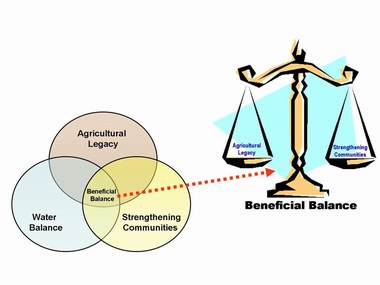Moving Towards a Water Balance Way-of-Thinking and Acting in the South Okanagan
A Synthesis of Conversations with Okanagan-Similkameen Residents
DURING THE FIRST WEEK OF NOVEMBER 2005 Tim Pringle of the Real Estate Foundation of British Columbia and Kim Stephens of the Water Sustainability Committee of the BCWWA spent three days meeting informally with a diverse group of Okanagan residents. Their objective in conversing was to gain an on-the-ground understanding of how communities in the Okanagan view settlement, economic growth and water issues.
Consultations carried out by the Regional District of Okanagan Similkameen in preparation for a Regional Growth Strategy have identified the availability and quality of water as the number one concern of South Okanagan residents
 Convening for Action in the South Okanagan, a program that is being delivered by the Water Sustainability Committee of the BC Water and Waste Association in partnership with the Province and others, is playing a role by bringing together people who have knowledge and expertise with those who seek ways to meet present and future water sustainability challenges in their communities.
Convening for Action in the South Okanagan, a program that is being delivered by the Water Sustainability Committee of the BC Water and Waste Association in partnership with the Province and others, is playing a role by bringing together people who have knowledge and expertise with those who seek ways to meet present and future water sustainability challenges in their communities.
The purpose in Convening for Action in the South Okanagan is to deliver a highly transparent process where everyone gets a voice, everyone sees their interests recorded and considered, and everyone is proactively engaged to focus on results.
WHAT WE HEARD AND LEARNED is documented in Convening for Action in the South Okanagan: Moving Towards a Water Balance Way-of-Thinking and Acting, released in February 2006.
To download this document, click on South Okanagan Consultation Understanding (February 2006)
In November 2005, we heard some heartfelt views about the landscape, water and change:
- The Landscape: People told us that the landscape with its agricultural legacy and traditional communities defines their place.
- Water Supply and Use: Water is critical to the way of life, yet water is not well understood; there is a sense that water could and should be better managed.
- Change: Pressures on land use generated by demand for recreational and other residential properties increasingly reflect change, with many residents becoming uneasy.
Communities are seeking ways to address these challenging priorities for land and water. The Town of Oliver has emerged as an on-the-ground case study opportunity for testing the application of a water balance way-of-thinking and acting.
THE FIRST ROUND OF CONVERSATIONS created the momentum for additional conversations with an expanding group about a ‘water-centric’ approach to planning. During the period November 2005 through February 2006, these additional conversations led to a decision by the Town of Oliver and the Oliver & District Community Economic Development Society to co-host a water-centric working session on March 30, 2006.
EXECUTIVE SUMMARY
Convening for Action is aimed at building capacity that leads to action. It is one of six inter-connected initiatives that comprise the Water Sustainability Action Plan for British Columbia. Key messages contained in this report are distilled as follows to provide a seamless storyline.
Water Stewardship
Under the Action Plan umbrella for advancing on-the-ground initiatives, the purpose in Convening for Action in the South Okanagan is to inform governments and others by engaging with “communities of interest and place” on the topic of water stewardship and sustainability. What we have learned through our recent conversations is presented as follows:
- Section 1 introduces the convergence of provincial and regional interests that provided the context for our conversations with a diverse group of individuals.
- Section 2 then identifies common threads and summarizes our key findings as to how communities in the Okanagan-Similkameen view population, economic growth and water supply issues.
- Section 3 follows with a framework to guide further conversations, brainstorming and dialogue regarding what may potentially be achievable in Convening for Action.
- Section 4 concludes with an outline of the Convening for Action Work Plan that will create the Okanagan case study foundation for Water-Centric Planning: A Guidebook for British Columbia.
To build trust and help facilitate the progression from conversation to dialogue to consensus on the relationship between water and land use in the Okanagan, we have created the graphic below.

Beneficial Balance
 “The three circles represent core concepts emerging from the discussion of settlement, economic growth and water supply pressures: the water balance way-of-thinking is what we brought to the discussion; you told us that agricultural legacy defines your sense of place; and we have concluded that strengthening communities is the key to protecting water,” explained Tim Pringle, “The intersection of these circles is the beneficial balance — that is, the integration of ‘made in the Okanagan’ principles, policies and programs.”
“The three circles represent core concepts emerging from the discussion of settlement, economic growth and water supply pressures: the water balance way-of-thinking is what we brought to the discussion; you told us that agricultural legacy defines your sense of place; and we have concluded that strengthening communities is the key to protecting water,” explained Tim Pringle, “The intersection of these circles is the beneficial balance — that is, the integration of ‘made in the Okanagan’ principles, policies and programs.”


